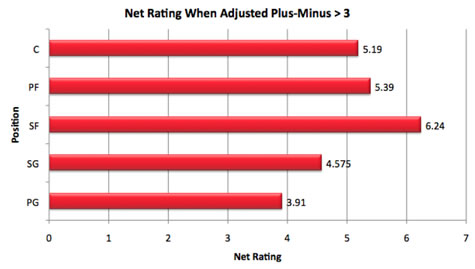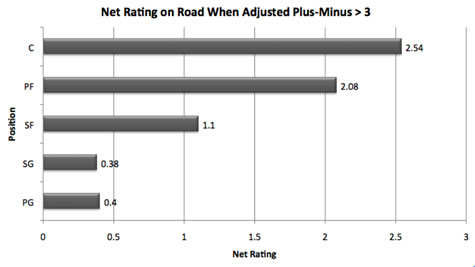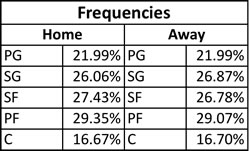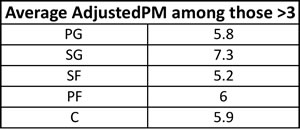Using the lineup data at http://www.basketballvalue.com, as well as the Adjusted Plus-Minus ratings, I’ve tried to figure out which positions are most crucial to a lineup’s (and team’s) success. My method was pretty simple. I calculated the average net rating (offensive rating minus defensive rating) of all lineups featuring a player with an Adjusted Plus-Minus of greater than three at each position. For example, if the average net rating for small forwards is five, then that means that all lineups featuring a good small forward (Adjusted Plus-Minus greater than three) beat the opposing lineup by an average of five points per 100 possessions. The easiest way to understand this is to look at it graphically:

Let’s look at the home and away splits:


Overall, it appears that small forwards are the most important, followed by power forwards, centers, shooting guards, and point guards. I’ve heard people suggest small forwards are crucial to a team’s success in the past. Three of the remaining four teams in the playoffs last year featured a small forward as their main playmaker. And as my study on the shooting abilities of small forwards showed, it’s best not to have a specialist at that position. What you need is a player who can do it all because that position appears to be very important to your team being successful.
Things get especially interesting when you look at the home/road splits. At home, small forwards still reign supreme. However, the little guys essentially catch up to the big men in terms of importance.
On the road, though, it appears having a solid interior is crucial. The importance of great guards is minimized greatly and centers and power forwards are well ahead of the rest of the pack.
Of course, there are a few potential concerns with this data, and I will explore two of them in this article. First, as always, there’s the question of sample size. Maybe point guards are just getting a bad rap because the sample size is too small and the ones that do qualify haven’t had that much success. Let’s take a look at the frequencies of each position having a player with an Adjusted Plus-Minus greater than three among all lineups:

I would say the sample sizes are pretty big. An observation I had was the relative lack of quality centers compared to other positions. Perhaps the complaints about there being no good centers nowadays are valid.
A second concern might be the quality of players in each position among those that qualify. In other words, if there are 20 point guards with an Adjusted Plus-Minus above three but they’re all at 3.01, it’s no surprise that they’ll look worse than the other positions. To see if this is a problem, I calculated the average Adjusted Plus-Minus for each position among those that qualify:

Three of the positions (point guards, power forwards, and centers) are bunched together, one is clearly lower than the rest (small forwards), and one is clearly higher (shooting guards). This evidence further supports the original conclusion I made that small forwards are the most important. After all, we have the weakest group to choose from at that position yet they still have the most positive effect. On the other hand, there are a lot of excellent shooting guards in the NBA, yet their impact is much less significant. And still, I have yet to find an excuse for point guards. They are often seen as the floor general and the player crucial to a team’s success, but remember who the two starting point guards in the Finals were (Derek Fisher and Rafer Alston). Of course, there are still potentially hundreds of hidden variables that could have an explanation for why my data underrates them.
In a few days, I will follow up on this study by taking a look at the other side: bad players. At which positions are bad players the most detrimental to a team’s success? Not only will it be a unique compliment to this study, but it also may shed some light on why today’s results look like they do. Stay tuned.